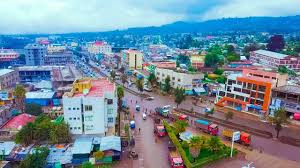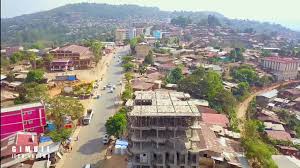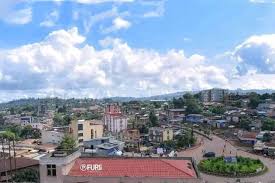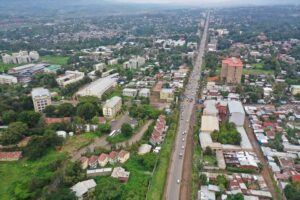When I set out to explore this town, located 126 kilometers south of Addis Ababa, I was armed with research from various sources, including Wikipedia. However, the essence of Asella, which I was able to experience first-hand and through interviews with locals, told me a different story—one that blended the historical significance, cultural richness, and natural beauty of the town with a very personal touch.
Asella sits at an altitude of 2,430 meters, a height that makes its climate cool and refreshing, something I appreciated as soon as I arrived. The air was crisp, and despite the sun’s rays, the temperature remained mild. This elevation is one of the many reasons that Asella is home to some of the greatest Ethiopian long-distance runners, but we will get to that in a moment.
Asella’s Historical Roots and its Strategic Importance
The history of Asella stretches back before the Second Italian-Abyssinian War. Interestingly, the town owes much of its early development to the Italian occupiers, who had grand plans for Asella. They envisioned it as a provincial capital. Yet, their efforts were short-lived, and they left behind only a handful of buildings—warehouses and a two-story structure that still exists today. It’s fascinating how colonial intentions can leave such a minimal mark, yet become part of a town’s foundation. The remnants of Italian architecture serve as a reminder of the town’s historical significance.
During World War II, Asella played a more prominent role. On April 10, 1941, the town was captured by the King’s African Rifles, part of the Allied Forces, after pushing past the Awash River. Asella was of strategic importance, offering the British forces a headquarters in the region. The remnants of this period, although less visible, linger in the memories of older generations who recount the time with a mix of pride and reflection.
While speaking to some of the locals, especially the elderly, I found that many of them had stories passed down from their parents or grandparents about the war and its impact on Asella. “This town has seen so much,” said one elderly man I spoke with. “From the Italians to the British, and now it is home to world-class athletes.”
The Athletic Heritage: Home of Champions
Asella has nurtured a legacy that transcends its geographic boundaries. This town is known far and wide for being the birthplace of some of Ethiopia’s most famous long-distance runners—Haile Gebrselassie, Kenenisa Bekele, Tirunesh Dibaba, and Derartu Tulu. These names are legends, not only in Ethiopia but globally. I felt an overwhelming sense of pride when speaking to the people of Asella about their athletes. It’s almost as if running is in the town’s DNA.
“Haile trained on these roads,” one young man told me. His eyes sparkled with excitement as he described the uphill paths where the Olympic champion would run. “Even now, we have children here dreaming of being the next Haile or Kenenisa. We run because it’s what we are meant to do.”
Walking through the streets of Asella, I could see how the environment naturally encourages athleticism. The rolling hills, the clean air, and the cool temperatures create the perfect training ground for endurance athletes. It’s no wonder that so many champions have come from this town. There’s even a sense that running is more than a sport here—it’s a way of life.
Nature and Climate: A Town of Serenity
Asella’s climate is categorized as subtropical highland (Cwb), which means that although the town is close to the equator, its elevation gives it a relatively cool and temperate climate. As a visitor, the weather was one of the most striking features of the town. Coming from the often hot and dry regions of Ethiopia, Asella’s refreshing climate was a welcome change.
The seasons here are marked not by changes in temperature, but by changes in the intensity of rain. The heaviest rains come in August, while the driest month is December. Despite being in the middle of the rainy season when I visited, the weather was still quite pleasant—an occasional drizzle, but nothing that would deter anyone from enjoying a walk through the town.
But the climate isn’t just comfortable for visitors; it also supports the town’s agriculture. Asella has a long history with farming, dating back to the 1940s when Swedish missionaries helped establish one of the first hospitals and schools in the area. Later, a government hospital was built, but the Swedish mission laid the foundation for modern healthcare and education in the town.
The lush greenery that surrounds Asella is not only aesthetically pleasing but also essential for the livelihood of its people. Walking through the surrounding areas, I saw farms that stretched as far as the eye could see. The combination of fertile soil and favorable weather conditions makes this region one of Ethiopia’s agricultural powerhouses.
Educational Significance and Asella’s Growth
In addition to athletics and agriculture, Asella is also a hub for education. With the establishment of Arsi University in 2015, the town has become a center for higher learning in the region. The university attracts students from all over Ethiopia, adding to the diversity of the population. As I walked through the university grounds, I spoke with a few students who were studying various subjects, from agriculture to medicine. “We come here because the education is good, and the town is peaceful,” one student told me. “It’s the perfect place to focus on your studies.”
The presence of the university has also contributed to the town’s economic growth. Cafes, restaurants, and shops have sprung up to cater to the growing student population, giving Asella a youthful and energetic vibe. This is in stark contrast to the town’s quieter, more traditional past.
A Glimpse into the Future
Asella is a town that is proud of its past, but its eyes are firmly set on the future. The people I spoke with were optimistic about what lies ahead for their town. With the continuing success of their athletes, the growing reputation of Arsi University, and the town’s ever-improving infrastructure, the future seems bright.
“We want Asella to be known for more than just running,” said one local shop owner. “We have so much to offer here, and we hope more visitors will come and see that.”
Indeed, there is much more to Asella than meets the eye. From its rich history to its athletic legacy, from its stunning natural beauty to its growing educational institutions, Asella is a town that offers something for everyone.
Final Reflections: A Personal Take on Asella
As someone who had only read about Asella before visiting, I found the reality of the town to be far more enriching than any article or historical account could convey. The pride of its people, the beauty of its landscapes, and the sense of possibility in the air all left a lasting impression on me.
The town has a way of blending the old with the new—whether it’s the remnants of Italian architecture from the 1930s, the stories of World War II, or the present-day achievements of its athletes and students. Each layer adds to the complexity and charm of Asella, making it a place that is not just worth visiting but worth experiencing deeply.
In conclusion, Asella is more than just a name on a map or a footnote in Ethiopian history. It is a vibrant and evolving town, with a rich past and a promising future. Whether you come for its history, its athletes, its climate, or its culture, you will leave with a deeper understanding of what makes this town so special. As a visitor, I can only hope to return someday to see how Asella continues to grow and inspire those who call it home.





